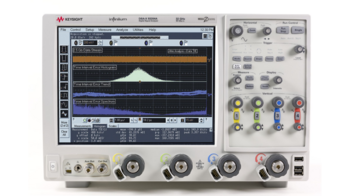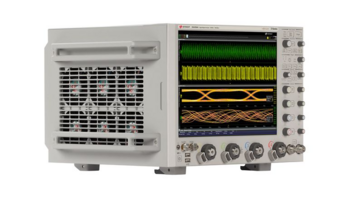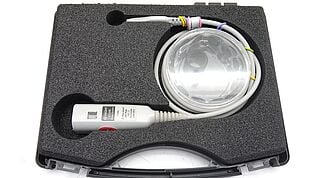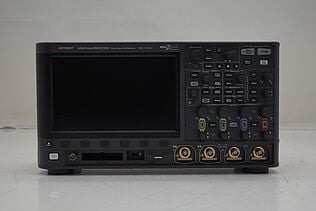- Introduction
- Why is Bandwidth Important?
- What is Maximum Bandwidth?
- What is Additional Bandwidth?
- Analog vs. Digital Bandwidth
- Factors Affecting Oscilloscope Bandwidth
- Probe Bandwidth
- Input Coupling
- Signal Conditioning
- Choosing the Right Oscilloscope Bandwidth
- Common Applications and Recommended Bandwidths
- Rule of Thumb: Bandwidth-to-Signal Frequency Ratio
- Relationship between Rise Time and Bandwidth
- Gaussian Response and Bandwidth
- Oscilloscope Bandwidth Limitations
- Effects of Aliasing on Bandwidth
- Considerations for Specific Applications
- Real-time vs. Equivalent-time Sampling
- Keysight Oscilloscopes
- Whenever You’re Ready, Here Are 4 Ways We Can Help You
Oscilloscopes are essential tools in the world of electronics, as they allow engineers and technicians to visualize and analyze time-dependent signals. One of the critical specifications of an oscilloscope is its bandwidth. This article will explore the importance of oscilloscope bandwidth, the factors that affect it, and how to choose the right bandwidth for your specific applications.
Bandwidth measures the range of frequencies an oscilloscope can accurately display. It is typically expressed in Hertz (Hz) or Megahertz (MHz) and is a crucial parameter when selecting an oscilloscope. The oscilloscope bandwidth determines the highest and lowest frequency signals that can be measured without significant distortion or attenuation. Both analog signals and digital signals can be characterized by their bandwidth, which is a crucial parameter for understanding their range of frequencies and how electronic devices can accurately process and transmit them.
Buy Oscilloscopes at a Great Discount
Why is Bandwidth Important?
- Signal Integrity: A higher bandwidth oscilloscope can accurately measure a wider range of frequency signals without losing important details or causing signal distortion.
- Frequency Response: Oscilloscope bandwidth determines the device's frequency response, which is essential for troubleshooting and diagnosing issues in various electronic circuits.
What is Maximum Bandwidth?
Maximum bandwidth is the highest frequency an oscilloscope can measure with minimal attenuation while maintaining signal fidelity. This parameter is essential to ensure accurate measurements, especially when working with high-frequency signals.
What is Additional Bandwidth?
Additional bandwidth refers to the extra frequency range beyond the maximum bandwidth that an oscilloscope can still measure, albeit with increased signal attenuation and potential distortion. While not ideal for accurate measurements, this extra range can be useful for general troubleshooting and observing signal trends.
Analog vs. Digital Bandwidth
Analog oscilloscopes have continuous bandwidth, meaning their frequency response is not limited by discrete sampling steps. Digital oscilloscopes, on the other hand, have discrete bandwidth, which is determined by the sample rate of the analog-to-digital converter (ADC) used in the oscilloscope. As a result, the effective bandwidth of a digital oscilloscope is usually lower than that of an analog oscilloscope with the same specified bandwidth.
| Key Takeaway |
|---|
| Oscilloscope bandwidth is a critical specification determining the range of frequencies an oscilloscope can accurately display without significant distortion or attenuation. |
Factors Affecting Oscilloscope Bandwidth
Several factors influence the oscilloscope bandwidth, including:
Probe Bandwidth
The oscilloscope probe is an essential accessory for making accurate measurements. The probe bandwidth must match or exceed the oscilloscope bandwidth to ensure accurate signal representation. A probe with a lower bandwidth than the oscilloscope can cause signal distortion and limit the system's overall performance.
Typical Probe Bandwidths
| Probe Type | Bandwidth Range |
| Passive Probe | 6 MHz – 500 MHz |
| Active Probe | 100 MHz – 8 GHz |
| Differential Probe | 50 MHz – 6 GHz |
Input Coupling
Input coupling can be either AC or DC. AC coupling filters out the DC component of a signal, while DC coupling allows both AC and DC components to pass through. Using AC coupling with high-frequency signals can cause signal distortion and reduce the effective oscilloscope bandwidth.
Signal Conditioning
Signal conditioning is the modification of a signal to make it suitable for measurement. This can include:
- Filtering
- Amplification
- Attenuation
The signal conditioning circuitry within the oscilloscope can also affect the bandwidth.

Choosing the Right Oscilloscope Bandwidth
To choose the appropriate oscilloscope bandwidth for your application, consider the following steps:
- Determine the highest frequency component of interest in your signal.
- Apply the Nyquist theorem: The oscilloscope bandwidth should be at least twice the maximum frequency of interest.
Common Applications and Recommended Bandwidths
| Application | Recommended Bandwidth |
| Audio Electronics | 20 MHz |
| Switching Power Supplies | 100 MHz |
| Microcontroller Development | 100 MHz – 500 MHz |
| High-speed Digital Design | 1 GHz – 8 GHz |
Rule of Thumb: Bandwidth-to-Signal Frequency Ratio
As a general rule, we recommend choosing an oscilloscope bandwidth that is five times the highest frequency component of interest. This ensures the oscilloscope can accurately display the signal's harmonic content and maintain measurement fidelity.
Relationship between Rise Time and Bandwidth
Rise time and bandwidth are related through a fundamental relationship that can be expressed using the following formula:
- Rise Time (in seconds) ≈ 0.35 / Bandwidth (in Hertz)
This formula is an approximation based on a Gaussian frequency response and is valid when the oscilloscope has a predominantly single-pole response. According to this relationship, an oscilloscope with a higher bandwidth can measure signals with shorter rise times, providing more accurate representation of fast-changing signals.
Conversely, if you know the fastest rise time of the signals you need to measure, you can use this formula to estimate the minimum required bandwidth for your oscilloscope:
- Minimum Bandwidth (in Hertz) ≈ 0.35 / Fastest Rise Time (in seconds)
Understanding the relationship between rise time and bandwidth is crucial when selecting an oscilloscope or evaluating the performance of electronic devices and circuits. By considering both parameters, you can ensure that your oscilloscope provides accurate measurements and can handle the signals you need to analyze.
Gaussian Response and Bandwidth
Gaussian response is a frequency response characterized by a smooth roll-off at higher frequencies. This response is named after the Gaussian function, which has a bell-shaped curve. In oscilloscope bandwidth, Gaussian response plays a significant role in determining the oscilloscope's ability to accurately measure and display signals without distortion or overshoot.
When an oscilloscope exhibits Gaussian response, it maintains a relatively flat frequency response within its bandwidth and begins to attenuate higher frequencies smoothly.

Oscilloscope Bandwidth Limitations
It is essential to understand that oscilloscope bandwidth is not a single fixed value but rather a range of frequencies over which the oscilloscope's performance degrades. The performance degradation usually occurs gradually, with higher frequencies experiencing more signal attenuation and distortion. This degradation is due to the frequency-dependent characteristics of the oscilloscope's internal components, such as amplifiers and filters.
Effects of Aliasing on Bandwidth
Aliasing is a phenomenon that occurs when an oscilloscope's sample rate is insufficient to accurately represent a high-frequency signal. It causes the signal to appear at a lower frequency than it actually is, leading to incorrect measurements and potential misinterpretation. To avoid aliasing, ensure that the oscilloscope's sample rate is at least twice the maximum frequency component of interest, as dictated by the Nyquist theorem.
Considerations for Specific Applications
Certain applications may require specialized oscilloscopes with unique bandwidth requirements. For example, radio frequency (RF) and microwave applications typically require high-bandwidth oscilloscopes with frequency ranges in the gigahertz (GHz) region.
On the other hand, power electronics applications may require lower bandwidth oscilloscopes with high voltage input capabilities and specialized probes for safe and accurate measurements.
Real-time vs. Equivalent-time Sampling
Real-time sampling involves capturing a continuous stream of samples at the oscilloscope's maximum sample rate, allowing for an accurate representation of the input signal. Real-time sampling is best suited for measuring single-shot or non-repetitive signals.
Equivalent-time sampling, on the other hand, captures multiple snapshots of repetitive signals and reconstructs the waveform over time. This method allows for higher effective sample rates, making it suitable for measuring high-frequency signals exceeding the oscilloscope's real-time sample rate.
Keysight Oscilloscopes
Buying a used oscilloscope is the best way to save money without sacrificing quality. You can save up to 90% when purchasing from Keysight Technologies!
We offer a wide range of high-quality, premium refurbished oscilloscopes backed by a 1-year warranty. You can be confident you are choosing a quality oscilloscope supported by a trusted manufacturer.
Check out our premium Used Equipment page to choose a premium refurbished oscilloscope with some of the highest standards and specifications in the industry.

Browse Oscilloscopes at a Great Discount
Select up to 3 instruments to compare
Enable Notifications
In order to use this feature, you need to enable notifications.
Manage notification preferences
Whenever You’re Ready, Here Are 4 Ways We Can Help You
- Browse our Premium Used Equipment.
- Call tech support US: +1 800 829-4444
Press #, then 2. Hours: 7 am – 5 pm MT, Mon– Fri - Talk to our sales support team by clicking the icon (bottom right corner) on every offer page
- Talk to your account manager about your specific needs








































